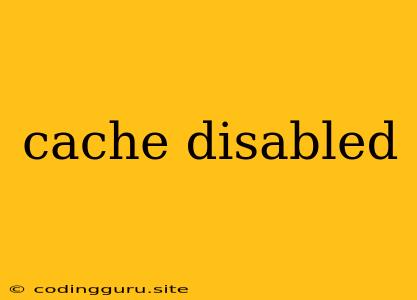What Does "Cache Disabled" Mean and Why Should You Care?
In the fast-paced world of web development, speed is king. Users expect websites to load quickly, and slow loading times can lead to frustration and a loss of potential customers. One crucial factor affecting website performance is caching, a technique that stores copies of frequently accessed data closer to the user, minimizing the need to fetch it from the server every time.
However, sometimes you might encounter the dreaded message "cache disabled." This can be disconcerting, especially if you're used to the performance benefits of caching. This article will shed light on what "cache disabled" means, why it might happen, and what you can do about it.
Understanding Caching: A Quick Primer
Before diving into the "cache disabled" issue, let's understand how caching works. Imagine you're browsing a website with lots of images. When you visit a page for the first time, your browser downloads all the images, storing them in your local cache (a temporary storage space on your computer).
The next time you visit the same page, your browser can load the images directly from the cache, bypassing the server entirely. This significantly speeds up the page loading process, leading to a smoother user experience.
Why is My Cache Disabled?
Several reasons could be causing "cache disabled," and understanding the cause is crucial for finding the solution. Here are some of the common culprits:
1. Browser Settings:
- Accidental Cache Clearing: You might have accidentally cleared your browser's cache, deleting all stored data, including images, scripts, and other website elements.
- Privacy Settings: Certain privacy settings might prevent your browser from storing website data in the cache, effectively disabling it.
- Browser Extensions: Some browser extensions or add-ons designed to enhance privacy or security might block caching to prevent data from being stored on your device.
2. Website Settings:
- Server-Side Caching Disabled: The website itself could have caching disabled on its server, either intentionally or due to a configuration error.
- Content Delivery Network (CDN) Issues: If the website uses a CDN, a temporary issue with the CDN could prevent data from being delivered efficiently, resulting in "cache disabled" behavior.
3. Network Issues:
- Intermittent Connection: A temporary disruption in your internet connection can prevent your browser from successfully accessing and storing website data in the cache.
- Firewall Restrictions: Your firewall or other network security measures might be blocking caching activity, preventing your browser from storing website data.
How to Troubleshoot "Cache Disabled"
Now that you know the potential causes, let's explore ways to troubleshoot "cache disabled" and get your website loading at peak speed.
1. Check Browser Settings:
- Inspect Cache Settings: Open your browser's settings and locate the cache settings. Ensure caching is enabled and that the cache size is set to a reasonable value.
- Disable Privacy Extensions: Temporarily disable any browser extensions or add-ons that might be interfering with caching to see if they are the culprits.
- Clear Cache: If you're sure your cache is causing problems, try clearing it completely, but be mindful that this will delete stored data for all websites.
2. Investigate Website Settings:
- Contact Website Admin: If you suspect the issue stems from the website itself, reach out to the website administrator to inquire about their caching settings and any known problems.
- CDN Support: If the website utilizes a CDN, contact their support team to investigate potential issues on their end.
3. Address Network Issues:
- Check Internet Connection: Ensure you have a stable internet connection. Temporarily disable your firewall or antivirus software to rule out any potential conflicts.
- Network Administrator: If you're using a shared network, contact your network administrator for help troubleshooting potential issues with caching on your network.
How to Force Caching:
In some cases, you might need to force caching on your browser to ensure that your website's content is stored locally. Here's how to do it:
- Ctrl + F5 (Windows/Linux) or Cmd + Shift + R (Mac): This keyboard shortcut forces a refresh of the page and clears the cache, ensuring that the latest content is loaded and stored.
- Browser Developer Tools: Open your browser's developer tools (usually by pressing F12), navigate to the "Network" tab, and check the "Disable cache" option.
Conclusion:
"Cache disabled" can be a frustrating experience, but understanding the potential causes and troubleshooting steps can help you get back on track. By ensuring your browser settings are optimized, investigating potential website issues, and addressing any network problems, you can restore the performance benefits of caching and enjoy a smoother, faster web experience.
